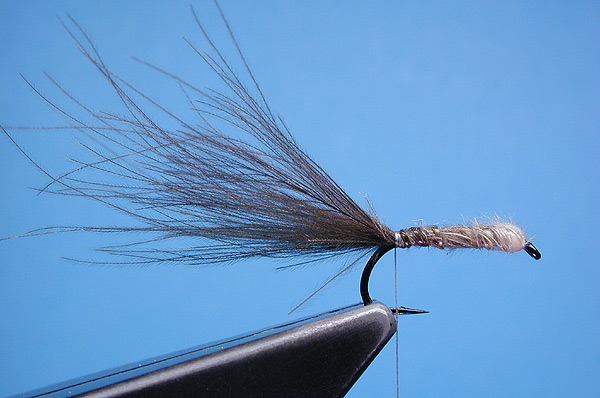IOBO Humpy
Originated by Jack Tucker, Pennsylvania, USA

(The materials are listed in the order they are tied in. Instructions assume righthanded tier.)
Tying instructions:
- Tie in a (Type 4) CDC feather, tied in by the butt at the eye of the hook

- Run the thread to the bend in touching turns

- Wrap CDC feather to bend, stroking the loose strands towards the bend with each turn, effectively bunching up the loose fibers as the CDC feather wraps further. When the bend is reached, you should have a hefty 'tail' of CDC fibers.

- Tie off the bunch with two turns of thread, then spiral
the thread to the eye of the hook in open turns over the body

- Pull the bunch of CDC fibers over the hook to form a shellback, tying it down at the eye, with the feather tips forming the wing, forward over the hook eye.
As the tips are kind of slippery, make staggered wraps with the thread through the tips to secure them securely. Lift the fibres up and secure them in an upright position with a couple of wraps. Whip finish in front of the wing to complete the fly.

Background:
Tying notes:
- The initial wraps with the quill are made quite 'soft', only tightening up after the wrapping is underway.
- I make sure the angle the initial wrap has to make is not such an acute one. I will tie in the stem in such a way that the stem comes off over the eye away from me, not parallel to the shank. I then make it go almost perpendicular to the shank by making a couple wraps in front, and tight up against it. Almost like propping up a wing. The result should be that the initial turn with the pretty stiff stem is a bit easier, with less risk of the stem splitting on me.
Fishing suggestions:
A typical slow water pattern it generally only lasts one fish, as the CDC slimes up easily. Then the fly needs to be retired to be rinsed and allowed to dry. However, often this pattern will manage to take the trout which have refused all previous offerings, which must count for something too ;-)
Background info on the IOBO, IOBO Humpy, and several other variations on the theme here.